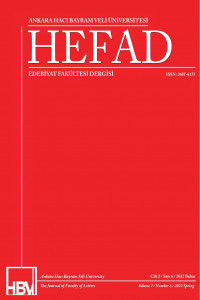OSMANLI DEVLETİ’NDE BİR TOPLUMSAL GÖZETİM VE DENETİM ARACI OLARAK 1880 HAPİSHANELER NİZAMNAME LAYİHASI
1880 Tevkifhaneler ve Hapishaneler Nizamname Layihası Osmanlı Devleti’nin
modern dönemdeki hapishane teşkilatının temel metnidir. Modern Osmanlı
hapishanelerine şimdiye dek tarih yazımında genellikle modernleşme paradigmasından
bakılarak bunların modern hapishane olmakta ne kadar başarılı sayılabilecekleri sorusu
sorulagelmiştir. Ancak bu perspektif Osmanlı hapishanesini gerçekten anlamayı imkânsız
kılmaktadır. Bunun yerine, modern burjuva disiplin toplumunun temeli olan hapishaneye
Osmanlı bağlamında da uluslararası burjuva toplumuyla bütünleşme sorusu üzerinden
bakılmalıdır. Keza bu bağlamda geleneksel Osmanlı elitleri olsun, mahalli topluluk
dayanışması temelindeki eski Osmanlı sosyal yapısı olsun, uluslararası burjuvazi ile ilişikli
modern Osmanlı bürokrasisince nasıl bir süreç içinde ve ne şekilde yerinden edildikleri de
analiz edilmelidir. Bu makale çalışmasında, bu konudaki kurucu yasal metinlerden biri olan
1880 Tevkifhaneler ve Hapishaneler Nizamname Layihası üzerinden işte tam da bu tür bir
inceleme ve analize girişilmektedir. Bu çerçevede öncelikle Michel Foucault’nun Batılı
orijinal bağlamdaki analizine dayalı bir şekilde çok kısa teorik bir giriş yapılmakta, ardından
1880 Hapishaneler Nizamname Layihası’nın ilginç kabul ve resmîleşme süreci
anlatılmakta, sonra da nizamname layihasının söz konusu analizi yerine getirilmektedir.
Bu analiz çerçevesinde üç ana unsur dikkat çekmektedir: layihada hapishane temelli
gözetleme ve disiplinin teorik olarak kurulması, sosyal güvenlik devletinin temelinin
atılması, modern kapitalist çalıştırma sisteminin yerleştirilmeye çalışılması. Bu modern
disipliner metnin Sultan II. Abdülhamid döneminde yazılıp ciddi şekilde uygulama konmaya
çalışılmış olması da söz konusu dönemin mahiyeti hakkındaki popüler ve tarihyazımsal
önkabulleri sorgulamaya bizi itmektedir.
THE 1880 PRISON REGULATION MEMORANDUM AS AN INSTRUMENT OF SOCIAL SURVEILLANCE AND CONTROL IN THE OTTOMAN EMPIRE
The 1880 Regulation Memorandum for Detention Houses and Prisons is the
basic text for the organization of the modern prison in the Ottoman Empire. Modern Ottoman
prisons have usually been viewed from the modernization paradigm in history writing until now,
and the question of how successful they can be considered in being modern prisons has been
asked. However, this perspective renders a real understanding of the Ottoman prison
impossible. Instead the prison, which is the basis of the modern bourgeois disciplinary society,
should be viewed in the Ottoman context, too, through the question of integration with the
international bourgeois society. Likewise, the issue of the process and way whereby not only
the traditional Ottoman elites but also the old Ottoman social structure based on local communal
solidarity were replaced by the modern Ottoman bureaucracy associated with the international
bourgeoisie should be analysed within this context. This is the exact kind of study and analysis
that is attempted in this article on the basis of the 1880 Regulation Memorandum for Detention
Houses and Prisons, which is one of the founding legal texts on this subject. Within this
framework, firstly, a very short theoretical introduction is made based on Michel Foucault's
analysis in the original Western context, and then the interesting process by which the 1880
Prison Regulation Memorandum was adopted and officialised is recounted, and finally the said
analysis of the regulation memorandum is conducted. Within the scope of this analysis, three
main components are noticeable; the theoretical establishment, within the memorandum, of
prison-based surveillance and discipline; the laying of the foundations of the social security
state; and the attempt to establish a modern capitalist employment system. The fact that this
modern disciplinary text was written up and was intended to be seriously put into practice during
the reign of Sultan Abdulhamid II obliges us to question the popular and historiographic
presuppositions about the nature of the period in question.
___
- BAŞOĞLU, T. (2011). "Ta'zîr". Türkiye Diyanet Vakfı İslam Ansiklopedisi, C. 40. Ankara: Türkiye Diyanet
Vakfı.
- CERİDE-İ MEHAKİM. (H. 1297). "Memalik-i Mahruse-i Şahanede Bulunan Tevkifhane ve Hapishanelerin
İdare-i Dahiliyyelerine Dair Nizamname Layihasıdır". Ceride-i Mehakim C.1, (45), 353-360.
- DEVLET ARŞİVLERİ. Teftişat-ı Rumeli Evrakı (Rumeli Müfettişliği): Müteferrik TFR.I..M.../1-1.
- DEVLET ARŞİVLERİ. Dahiliye: Hapishaneler Müdiriyeti: Müteferrik DH.MB..HPS.M./31-82.
- FOUCAULT, M. (1975). Surveiller et Punir: Naissance de la Prison. [Paris]: Gallimard.
- FOUCAULT, M. (1991). "Questions of Method". Graham Burchell, Colin Gordon and Peter Miller, The
Foucault Effect: Studies in Governmentality (with Two Lectures by and an Interview with Michel
Foucault) içinde. Chicago: The University of Chicago Press, 73-86.
- FOUCAULT, M. (1992). Hapishanenin Doğuşu, çev. Mehmet Ali Kılıçbay. Ankara: İmge Kitabevi.
- FOUCAULT, M. (1995). Discipline and Punish: The Birth of the Prison, trans. Alan Sheridan. New York:
Vintage Books.
- İPŞİRLİ, M. (2019). "Kürek Cezası". Türkiye Diyanet Vakfı İslam Ansiklopedisi, C. EK-2. Ankara: Türkiye
Diyanet Vakfı.
- ROTH, M. P. (2014). An Eye for an Eye: A Global History of Crime and Punishment. London: Reaktion
Books
- SCHULL, K. F. (2014). Prisons in the Late Ottoman Empire: Microcosms of Modernity. Edinburgh: Edinburgh
University Press.
- TÜRK TARİH KURUMU (TTK) (t.y.). Tarih Çevirme Kılavuzu, Türk Tarih Kurumu resmî web sitesi. Web:
https://www.ttk.gov.tr/tarih-cevirme-kilavuzu/.
- YILDIZ, G. (2012). Mapusâne: Osmanlı Hapishanelerinin Kuruluş Serüveni (1839-1908). İstanbul: Kitabevi.
